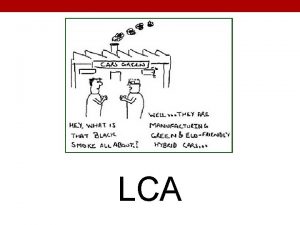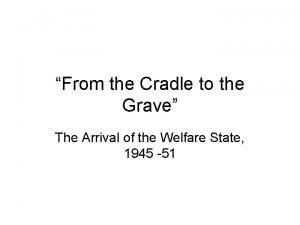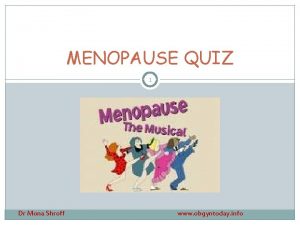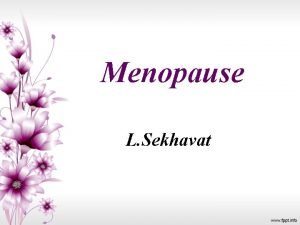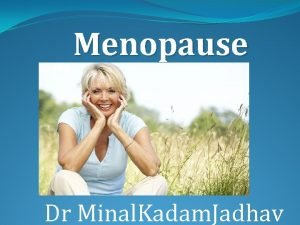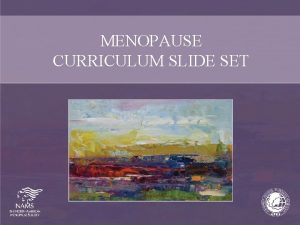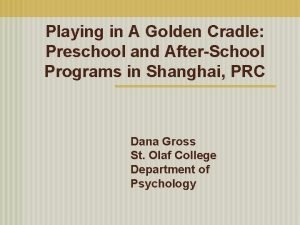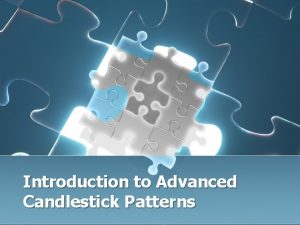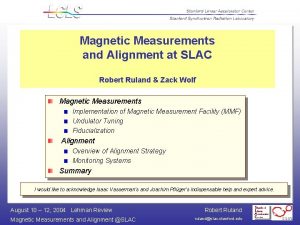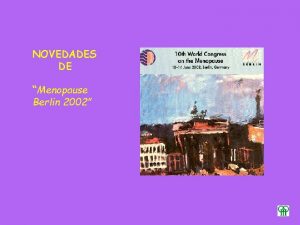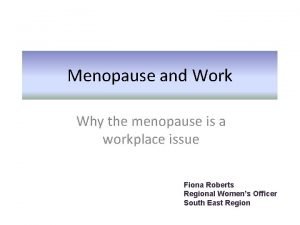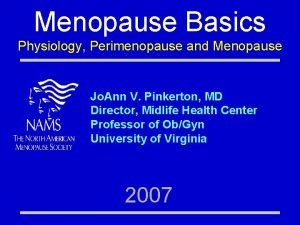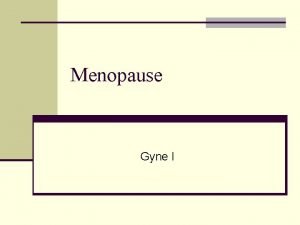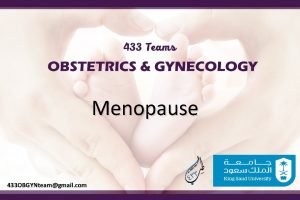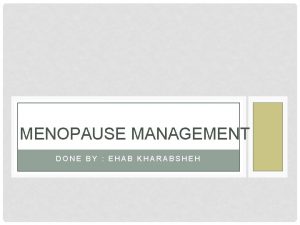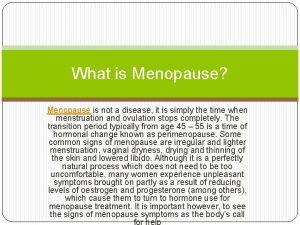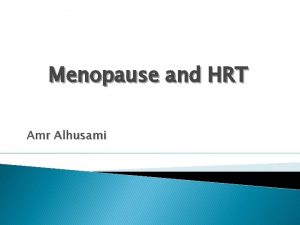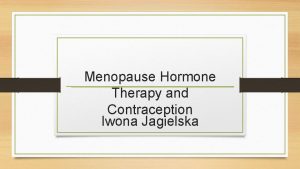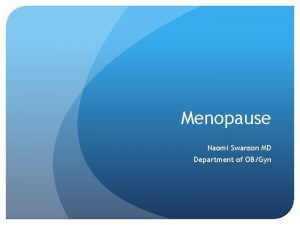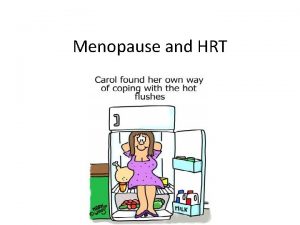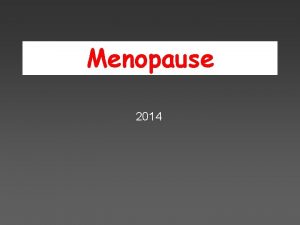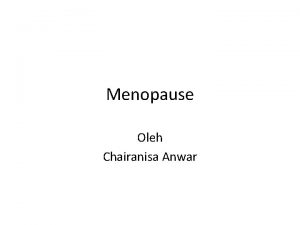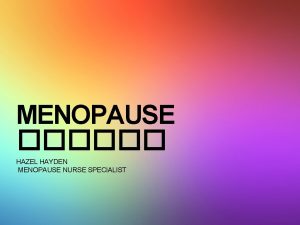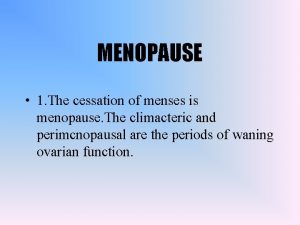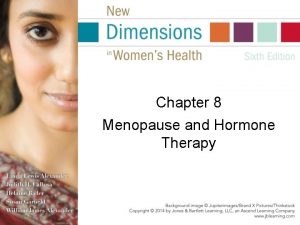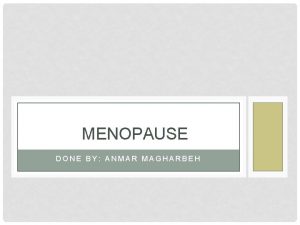Middle Age I Menopause FROM CRADLE TO GRAVE













![Menopause and mannishness Masculine Character ‘When the change [of life] is past, the mind Menopause and mannishness Masculine Character ‘When the change [of life] is past, the mind](https://slidetodoc.com/presentation_image_h/2366214ab92a3f57bd67d609fe438598/image-14.jpg)










- Slides: 24

Middle Age I: Menopause FROM CRADLE TO GRAVE TERM 2, LECTURE 7 (WEEK 9)

Marie Stopes, Change of Life in Men and Women (1936) �The ‘crises’ of a woman’s life have been much descanted upon by men medical writers [and] perhaps the most artificially created has been her ‘change’.

Themes and Questions �Is menopause a natural process or pathological/disease – medicalisation? �Aging and menopause �What does it tell us about attitudes to women? And older women? Connections to family, marriage and workplace? �Impact and responses of feminism – 1 st and 2 nd wave �Role of pharmaceutical industry �Sources – Lancet, archives of Women’s Medical Federation, magazines, advice literature – all debate menopause �Excellent case study of connections between gender and medicine

The ‘clinical’ change � When in life cycle? Average 51. Usually occurs between ages of 45 and 55. � The ‘climacteric era’ � Peri-menopause – according to orthodox medicine ‘ovaries start to fail’ a year or two prior to menopause proper � Process can take up to 4 years � Symptoms? hot flushes, irregular menstruation, emotional change � Post-menopause – time following permanent cessation of menstruation � The menopause is caused by a change in the balance of the body's sex hormones i. e. During peri-menopause oestrogen and progestrogen levels decrease, causing the ovaries to stop producing an egg each month (ovulation). Oestrogen is the female sex hormone that regulates a woman's menstrual cycle.

Medical debut � Menopause made ‘debut’ as medical entity in early C 19 th though physicians elaborated on it in C 18 th � Linked increasingly to ‘pathology’/disease not ‘normality’ � Diseases peculiar to women (across reproductive life cycle) – doctors identify a series of unpleasant, even fatal, complaints � Language of ‘symptoms’ - hot flushes, sweats, weight gain, backache, fatigue, headache, dizzy spells, irritability, nervousness, apathy, depression, emotional instability, feeling of suffocation, forgetfulness, insomnia, panic, chest pain, breast pain, constipation, diarrhoea, changes in libido, anxieties about the body � More recently concern with osteoporosis – this not specifically associated with menopause, but part of aging process and also effects men � More generally problems of aging confused with menopause

18 th century interpretation �Dr John Hunter (1728 -1793): ‘The female, at a much later time of life, when the powers of propagation cease, loses many of her peculiar properties, and may be said, except from mere structure of parts, to be of no sex, even receding from the original character of the animal, and approaching, in appearance, towards the male, or perhaps more properly towards the hermaphrodite. ’ �Yet social standing of post-menopausal women might be high in early modern period.

C 19 th pathology �Samuel Ashwell (1798 -1852) - ‘organic maladies’ more likely to take place than at any other time �Characterised by physical decline, disorder and diminished functions (even though women lived longer than men and in better health). �Seen as final stage before death – N. B. ‘relative’ old age began at 45 in C 19 th (F. B. Smith, The People’s Health) �‘The vigour of the reproductive system begins to decline about the age of forty or forty-two; and from this period to the age of forty-nine, there is a state of the system analogous to that of the period when it first developed…’ (Thomas Laycock, The Morbid Phenomena of Menopause, 1840)

Ages of man and woman – prime of life?

C 19 th pathology: Michael Ryan, A Manual of Midwifery (1841) ‘Cessation of menstruation. Senile sterility. The menstrual secretion ceases, in temperate countries, about the forty-fifth or fiftieth year… When menstruation is about to cease, the period is called critical, ‘the change, or turn of life, the climacteric period; ’ and many important changes take place in the constitution at this epoch. All the characters of puberty and the peculiarities of women cease, the breasts collapse… the skin shrivels, … and many diseases develop… in the womb, ovaries and breasts, which had lain dormant for years… When this period has, however, passed, women often enjoy better prospects of health and of long life and the other sex, and become remarkably corpulent. ’ �(See Jalland Hooper extracts for more e. g. s)

The Menopause and Mental Illness – Climacteric Insanity � C 19 th ‘climacteric insanity’ or ‘involutional melancholia’ or ‘old maids’ insanity’ � ‘Climacteric perturbation (1873) ‘Climatic convulsive diseases. At the ‘turn of life’ … the nervous system… exhibits frequent and various perturbations. Thus we find giddiness, vertigo… impairment of memory, mental irritability… culminating in some cases… in epilepsy, and even in insanity… It is a stage of transition and trial for all. These perturbations may persist for months, even for years, before the balance is restored… many women may have passed through the trials of puberty and of child-bearing without serious nervous disorder, and will break down at the menopause. Often, no doubt, this is the climax, the last ounce of a long-troubled sexual life’. Robert Barnes, in Lancet, 26 April 1873

Evidence from case books (Wellcome Library WMS 5158, Holloway Sanatorium, Case Book No 4, females admitted July 1890 -June 1891, pp. 29 -30) Patient No. 665, admitted Aug 13 90 Ada Marianne R. , 47, single, no occupation. Ch of England. Previous abode Besborough [Benborough? ] Gardens, Pimlico. This is the first attack of two months duration, age on attack being 47. Supposed cause previous illness- the Climacteric. Is subject neither to epilepsy, nor suicide, is not dangerous to others. R [reception] order: Charles Matthew Cloke [? ] 1 st Certif: Very wild in conversation and restless. [illegible] thieves in the home and sees the back of the house lit up like a fire Thos. Langton nd 2 Certif: Rambles incoherently says that I am not Dr Pearce she was acquainted with. Sometimes is violent in attempts to leave her nurses. George Pearce. Fam Hist: [blank] Previous Hist: [blank] Condition on Admission A: Physical: Tall thin woman, bluish green eyes, pupils equal and react. Light brown hair, pale, anaemic, freckled complexion, haggard, anxious expression, sunken cheeks, prominent [illeg, malar? ] bones. Complains of headache, bowels constipated, tongue coated with thick moist fur, tremulous, appetite bad, sparely nourished and thin, but presents no physical sign of disease in thoracic and abdominal organs. B: Mental: Acute Melancholia. Restless, agitated, confused, incapable of settling down to any occupation. Hallucinations of taste and hearing, delusions of identity respecting clothing, refuses all food and says that she is a great sinner.

George Savage, ‘Mental Diseases of the Climacteric’, Lancet October 31(1903), pp. 1209 -1213. Available through library. �‘She is restless, she is here, there, and everywhere upsetting everything and everybody… The unfortunate husband suffers grievously under such conditions. . . Kleptomania is more commonly met with in the climacteric women than in any others… But I think you have already perceived that disorders of the menopause are, in the greater proportion of cases, of a depressed type, melancholic, hysterical, with ideas of misery and persecution and watching…A considerable number of these patients make an end of themselves, drowning perhaps being the most common means…’

Menopause and meaning �If meaning of Victorian women’s life was characterised by maternity, was the end of reproduction typified by loss of meaning? �Social predicament of women in C 19 th? �Simone de Beauvoir – if medical discourse invested reproductive femininity with elements of ‘service’, the same discourse rendered women useless after the cessation of reproductive life. Rich in experience and ‘in full possession of her powers’, women of 50 were retired. Simone De Beauvoir, The Second Sex (1949).
![Menopause and mannishness Masculine Character When the change of life is past the mind Menopause and mannishness Masculine Character ‘When the change [of life] is past, the mind](https://slidetodoc.com/presentation_image_h/2366214ab92a3f57bd67d609fe438598/image-14.jpg)
Menopause and mannishness Masculine Character ‘When the change [of life] is past, the mind emerges from the dark clouds in which it has seemed lost. Thankful that they have escaped from real sufferings, women cease to torture themselves with imaginary woes. They feel the ground grow steadier underfoot, they are less dependent on others, - for like the body, their mental faculties assume a masculine character… it imparts a firmness of purpose… whether it be to govern a household, to preside in a drawing-room, or to thread and unravel political entanglements. When women are no longer hampered by a bodily infirmity periodically returning, they have more time at their disposal, … and the faculties of mind become endowed with new vigour. ’ E. J. Tilt, The Change of Life in Health and Disease, 2 nd edn, 1857

Medicalisation �Ivan Illich – ‘medicalisation of life’. Rapidly expanding medical profession of C 19 th faced with healthier population, medicated normal life events, turning risks into diseases and pathologising normal processes. �I. K. Zola - ‘medicine is becoming a major institution of social control… the new repository of truth, the place where absolute and often final judgements are made by supposedly morally neutral and objective experts’. �Are women’s experiences more likely to be medicalised than men’s? Why? �What are the strengths and weaknesses of medicalisation theory? How does it effect women’s experiences and agency?

Current depression �Those who argue that depression is caused by endocrine changes believe it is curable by reestablishing hormonal balance. �Psychiatrist Dr Raj Persaud defined menopause as ‘disease’. Though a ‘completely normal biological event’ it ‘attracts quite problematic medical symptoms’. These should be treated not because normal or abnormal but because ‘desirable’ if leads to suffering. �So should life itself be medically treated? �(See Persaud’s Gresham College Lecture 2005)

Hormones �Endocrinology… After 1910 research on menopause dominated by study of hormones �A woman became a ‘plaything of her glands’ – remodelled menopause as hormone deficiency disease �Medications addressed hot flushes, mood swings, palpitations, etc caused by the change in the balance of hormones in the body �HRT – oestrogen used since 1930 s to treat hot flushes. After 1960 s use of hormones increased – possibility of remaining ‘feminine forever’ (Dr Robert A. Wilson). Huge market for pharmaceutical companies. Debate continues about benefits and risks….

Menopause and pharmaceutical industry

Medical Women’s Federation research (See J. -M. Strange, ‘In full possession of her powers’, SHM, 25, no. 3 (2012), pp. 685 -700) � Initiated research on menopause 1926 after their campaign aimed at adolescent girls on menstrual health – which urged good menstrual hygiene while challenging disability associated with menstruation. � Letitia Fairfield – survey of professional women and absenteeism 1922. Concluded ‘critical time’ had limited impact on women’s abilities. Criticised earlier work which related ill health between ages of 40 -55 to menopause as lazy diagnosis. � MWF sub-committee – 1, 220 questionnaires. Results published in Lancet (1933). Symptoms of menopause muted for many women. 90% claimed that they ‘carried on their daily routine without a single interruption due to menopausal symptoms’. � Served economic and ‘political’ purpose – survey used to justify women’s work in Second World War.

Women’s voices � From late C 19 th advice to women on health in popular media. Consider female life cycle as whole. � e. g. magazine Quiver series of articles on middle age and its management by Elizabeth Sloan Chesser (eugenicist physician). � WMF report developed responsibility of women and their newsletter also advertised tonics to treat older women’s complaints. � Dr Josephine Barnes (1912 -99) – radio broadcasts 1948 – hormonal changes, menopause and cancer. Janet Quigley Woman’s Hour – hush-hush topics into open (1950). � Marie Stopes and Joan Malleson, Change of Life (1936, 1948) � Jenni Murray, author of Is It Me or Is It Hot in Here: A Modern Woman’s Guide to the Menopause (2003? ): ‘The menopause can be the scariest of rites of passage for a woman. ’

Tonics

Feminist responses �In 1970 s feminists began to challenge orthodox medical model of menopause – viewed it as a positive transformation. �They suggested its medicalisation was a conspiracy to produce a submissive female patient who could be treated with drugs. � 1945 Helen Deutsch referred to menopause as a ‘partial death’ in which ‘everything [a woman] acquired during puberty is lost piece by piece…’ �No evidence of increase in depression. Though Greer in 1992 writes of the menopause as ‘a time for mourning… the menopausal woman should be allowed her quiet time and her melancholy’.

Male menopause � 1910 - nerve doctor Kurt Mendel introduced idea of male menopause. Attracted much attention early part of C 20 th � Associated with sexual and physical decline � Concern about sexual decline – efforts at medical rejuvenation. Serge Voronoff – monkey gland operation (mid-1920 s) � Poet W. B. Yeats’ vasectomy – revive sexual and creative power (1934) � Hormonal treatments for impotence introduced in late 1920 s. 1935 testosterone isolated and Organon manufactured Testosteron in 1937. � Sex aids to Viagra (1998) � Lived on in popular press more than medical literature 19501990 s

Conclusion � In what ways is the menopause a valuable case study for considering the relationship between gender and medicine? � How has menopause been re-conceptualised since the 19 th century? � How have older women’s experiences been medicalised – if you agree they have been? � How useful did you find Greer’s book, The Change?
 Cradle to grave cradle to gate
Cradle to grave cradle to gate Cradle to cradle boeken
Cradle to cradle boeken Cradle to grave housing report
Cradle to grave housing report Cradle to cradle design
Cradle to cradle design Compact city
Compact city Cradle to grave
Cradle to grave Sven jani
Sven jani Stone age, bronze age iron age timeline
Stone age, bronze age iron age timeline Iron age bronze age stone age timeline
Iron age bronze age stone age timeline Premature menopause quiz
Premature menopause quiz Symplex f for menopause
Symplex f for menopause Menopause wann
Menopause wann Menopause definition
Menopause definition Menopas
Menopas Dr wilson adrenal rebuilder side effects
Dr wilson adrenal rebuilder side effects Menopause definition
Menopause definition Leg cradle to lateral lunge
Leg cradle to lateral lunge Golden cradle kindergarten
Golden cradle kindergarten Mesopotamia the cradle of civilization worksheet answers
Mesopotamia the cradle of civilization worksheet answers Who is uncle gregorio
Who is uncle gregorio Cradle of liberty merit badge college
Cradle of liberty merit badge college Cradle of the renaissance
Cradle of the renaissance Cradle candlestick pattern
Cradle candlestick pattern Cradle alignment technique
Cradle alignment technique Scholarship merit badge
Scholarship merit badge
